|
|

Sellers' Corner
Walter Shawlee 2, Kelowna, BC, Canada
The Slide Rule Universe
Bizarre Late Night Experiments
The huge temptation when you have a lot of slide rules, and many of them are not in the best of shape, is to try and correct things that have gone horribly wrong. The thought is that if you can restore the rule, all is well with the world, and if it goes badly, itís only your ugly number 4 example, and so not a tragedy of epic proportions.
This state of mind over the years has led to some experiments that seem fairly horrifying in the re-telling, but at the time seemed fairly inspired. This is probably what comes from conducting slide rule experiments late at night after a long day.
No doubt all of you have seen the results when somebody slips a small pocket rule into their back pocket, and then sits on it for a while. The rule gradually becomes curved in the worst possible way, and barely moves. I got a few nice little Post/Hemmi bamboo rules like this a while back, and wondered if I could make them flat again. After considerable rumination, I thought that possibly soaking them in warm water to make the bamboo more pliable, then suspending them between two blocks, with a heavy weight in the center on the raised part of the curve, might make it flat again. After several variations, and considerable wreckage, I can only report that this experiment was a total failure, yielding worthless, delaminated body parts, and only some spare cursors for my efforts. Never deterred, I tried it on a plastic rule or two, and managed to make them flat, but so tightly jammed, they were literally unmovable. Rats.
Scale bleeding on Faber Castell rules has always made me crazy, as it really changes beautiful rules into elaborately decorated paint-stirring sticks when itís bad. As I related earlier, I was able to reverse and correct bleeding on black scales by sun bleaching, and many rules can be restored to perfect condition by this technique. Well, this simply begs the inevitable question; can it be done without the sun? This is an important issue for me, because where I live in Canada, this technique only works briefly in summer. I bought a UV sterilizer from eBay, and tried days of exposure to try and duplicate the sunís effects. Sadly, no luck.
Many days and rules later, I found that only the combination of very high energy UV (far in excess of what the pitiful UV sterilizer lamp provides) AND heat, drives the unwanted pigment out of the body material, which then evaporates or bleaches clean. Not the best news for me, as I get only about 6 months of the year when this works properly outside, but I know a few people had wondered if it could be done, so ever the fearless experimental scientist, I tried it.
I was actually able to make sun bleaching work outside in winter on a few days with clear skies and very bright sunlight, but the low sun angle meant little UV or heating, and it took over a week to do what I could do in a few hours in June. Couriers delivering packages to our place have gotten used to the weird sight of slide rules tilted up towards the sun all over our outside shipping table. I donít know if I should be concerned or not at the fact that they often leave shaking their heads and muttering.
The red scales also bleed sometimes, and my luck with solar bleaching has been only so-so here. The distinct orange ďPumpkin Colored BlightĒ as Larry Stewart calls it has proven largely resistant to my best efforts, which have included sun bleaching, solvents, heat, sanding and frustrated bouts with my heat gun. The score is Blight 10, Walter 0 so far. Whatever that pumpkin colored stuff is, itís pretty tough.
Sometimes, I get a rule that just wonít slide, more of a stuck rule. Later K+E rules in both wood and Ivorite seem oddly prone to this, probably due to deteriorating workmanship at the end. I found bodies with badly shaped tongue and groove construction, holes mis-located on the body parts (resulting is high stress mis-alignment, and curved body parts) and very high friction on the sliding surfaces. Armed with assorted pattern files, scotch brite pads, sand paper, and Pledge, I have savaged these stubbornly stuck rules back into smooth operation with about a 50% success rate. The ones that proved the most uncooperative were always the nice looking late model K+E 4181/68-1251 style rules that simply were mis-made. Often I just canít make the parts align, no matter what I do, and I have had scales between body and slide with up to an 1/16Ē difference in length. Yes, these do become the eventual sources of spare cursor and body screw parts. I have already related my demented trick with a steam kettle to fix the K+E collapsed cases, sometimes itís just amazing what actually works when you try it.
Perhaps my most interesting experiments have been with Pickett rules. There are some serious questions to be answered there, like are the photographically reproduced parts more interchangeable than engraved parts? Yes, it turns out, rules of the same scale production run are very interchangeable, and often align beautifully, and I have some strange Frankenrules to prove it here: http://www.sphere.bc.ca/test/frankenrule.html
The next problem was to try and clean objectionable spots and blotches from the body, here the answer was unfortunately NO. Once marked, the painted surface canít be effectively cleaned without damaging the rule. Badly corroded end braces canít be un-riveted and replaced easily, but I found they could be restored with a lot of patience, and a Dremel tool and polishing head, often to like new brilliance. Those unobtainable aluminum body screws still elude me, however, I have yet to find any generic aluminum replacements that really work. As a result, I have a small Pickett graveyard slowly filling up with corroded, bent, scratched and scavenged rules.
So, over all, I think no true harm has been done, and a lot learned by some of these efforts. You just never know what will work until you actually try it.
All for now,
Walter
walter2 ďatĒ sphere.bc.ca
The Slide Rule Universe
|

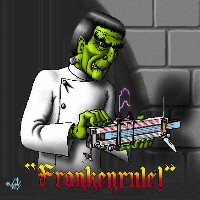
Frankenrule!
|
SlideLites
Dick Rose, Columbus, Ohio
Vintage Instruments
89 Pounds of Slide Rules
As most of you probably remember, I shipped 89 pounds of slide rules out to the Las Vegas Oughtred Society meeting in February. (Special thanks to Richard Davis, who not only hosted the meeting, but received the shipment and lugged it to the meeting site, the Atomic Testing Museum, which, by the way, was a blast. ? Sorry, I couldnít resist.)
Anyway, after the meeting, I packed everything up, took the boxes to FedEx (thanks for the ride, Ted), and sent them back to Columbus. They are currently sitting, unopened, in my office. Iím trying to get the final work done on the new version of my web site and havenít had time to open the boxes.
However, it just occurred to me that had I brought back more than the 89 pounds of slide rules that I had taken with me -- a total of 99.4 pounds to be exact. I purchased more, weight-wise, than I sold. So, in that sense, I brought back more than I had taken, which is fine since I now have some things that I needed.
But I also brought back more than I took in another sense. I brought back mental images of friends that I have known for years, but had never before met in person. I brought back memories of a fine meeting which included good food, good friends, and a wonderful performance by The Great Koppany, fully consistent with Las Vegasí reputation for excellence in entertainment. If you donít know about The Great Koppany, youíll just have to come to a future meeting.
I hadnít attended a Society meeting since my first, eight years ago, but I plan to rectify that and attend as many as I can in the future. And let me encourage you to do the same. The greatest part of the meeting is the people, and the more the better. It may sound strange to your friends and family that you spend your time going to slide rule meetings, but what the heck, everyone already knows that you are strange, being a slide rule collector. ?
So I took 89 pounds of slide rules to the meeting, but I came back with more, so much more. Please join me/us at future meetings. You too will take home more than you came with.
Dick Rose,
Vintage Instruments
|

|
Early American Slide Rules
Kate Matthews, Sonora, California
Slide rules, like many other technologies, were originally imported to America from Europe. The how and when of early American slides rule use remains a fascinating area for study. It seems reasonable to assume that American slide rule use corresponded to the development of our indigenous engineering programs. Before Keuffel & Esser, there appear to have been only a few lesser makers of slide rules and slide rule type devices in the Untied States. As has been much documented, K+E, first began imported their slide rules. Sometime around the turn of the 20th century, they began to manufacture their own rules. These new rules were distinctive from their European counterparts. How can you tell whether an early American branded rule was made here or in Europe? One quick indicator exists. It is the style of the engraving for the scales. European slide rules typically delineated the top of each scale with a horizontal line, while American made rules do not.
An American branded slide rule that has European style scales is always worth a second look.
|

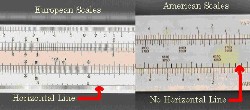
|
Thacher Calculator Reproduction
David White, Essex, Massachusetts
About four years ago I found a pair of old slide rules tucked in a drawer in my desk along with various other forgotten memorabilia I have acquired over the last 35 years. One was an old Post 1441 that belonged to my father, and the other was a Concise circular slide rule I used in high school. My favorite, a Keuffel & Esser 4081 seemed to be missing, so I decided to see if one might be available on eBay (I can see all your smiles). I couldnít believe my eyes, at any given time there were over 500 slide rules available. That was, as they say, the beginning of the end. I have been a slide rule collector since.
At first I started buying just about any slide rule that looked interesting, but I finally realized I had to limit myself and settled on collecting Keuffel & Esserís, and to me, the most interesting slide rule produced by K&E was the Thacher Calculator. I own three now, and although I would like to leave one out on display, I consider them too valuable to leave them out for the humid New England climate to affect the scales, or for one of my rambunctious teenagers to knock it over. So when I saw downloadable scales for a Thacher Calculator on Mike Konshakís website, www.sliderulemuseum.com, I knew I had found the answer.
I have built nine Thacher Calculator reproductions so far. The first one was a little rough, but I learn a little more with each example and they keep getting better and better. I gave the first two away, and have sold a few more on eBay, but anyone with a little modeling or woodworking experience should be able to build their own. Mike has a pdf file on his website that describes how I built the first one, but I would like to offer a few pointers Iíve learned along with some construction photos.
-
I use ľ x ? basswood for the bars (available at Balsa USA) and miter-sand it to a triangular cross-section having two ?Ē sides and a ľĒbase.
-
I started using craft felt for the underside of the bars, but found that pool table felt is stronger.
-
To cut the felt into 3/16Ē wide strips I glued it to a manila folder using repositionable spray adhesive and cut it using a hobby knife with a very sharp blade.
-
I used spray satin finish polyurethane instead of the Krylon Crystal Clear to give it a more mellow finish. This will also amber slightly to make it look antique.
-
Be very careful lining up the paper scale on the drum. Alignment is critical and you only get one chance.
-
3M #77 spray adhesive seems to work well, but to help it keep the paper scales glued to the bars I paint contact cement on just the wooden bars first, and then spray the paper scales with the spray adhesive.
-
Have plenty of sharp hobby blades available. I use about 40 to make one calculator.
These are some of the things I have learned, but if anyone comes up with some addition pointers please email me. Also, I made set of abbreviated instructions for the base using a math program and I am willing to send it to anyone who would like it. This is just a hobby for me, not a business, so Iím willing to help anyone who would like try to build their own. I would estimate the total construction cost including supplies to be about $80, and it usually takes me about 20 hours of work over the course of a couple of weeks to make one.
Good Luck!!

|

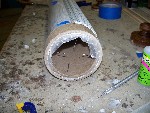
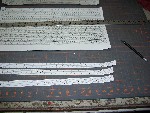
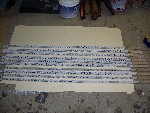
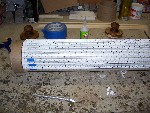
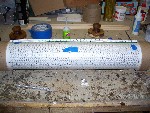
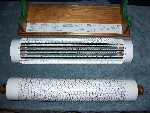
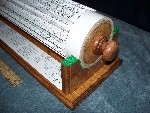
|
My Favorite Slide Rule: The Hemmi 260-X...or, Confessions of a Slide-Swapper
Warren Salomon, Miami, Florida
Near the end of the slide rule era, Hemmi offered three top-end, general-purpose, duplex slide rules made of bamboo -- the Versalog II (hereafter V-II), the 259D, and the 260. Each has a slightly different collection of scales and features, and I don't find any one of them to be my ideal. But these rules all have slides which are physically interchangeable, so after considering the pros and cons of each model, we can make some improvements with a well-chosen slide swap. (The 254 WN could be considered part of this high-end group, but most variants had CF/DF scales that weren't folded at pi, so their slides aren't swappable.)
Alone in this group, the V-II has several convenience features on the trig scales -- a green cosine scale, decimal point locators, and SRT marking. Further, it is the only rule to have R1/R2 scales (a double-length C scale for square roots).
The V-II and the 260 both have other convenience features -- self-documenting symbols and LL scale range indicators. These are lacking on the 259D.
The 260 is the only rule in this group to have a P scale. Unfortunately, it is unique in another way -- it is the only rule that lacks sub-numbers between 1 & 2 on the C/D scales, which detracts from the readability of those frequently-used scales. Instead, the 260 has "1.5" in the middle of that range. It's functional, but I prefer the full range of sub-numbers on the V-II and the 259D.
The 259D and the 260 have extra-thick end-brackets which elevate and thus protect the cursor when the rule is laid on a tabletop. The Versalog never had that feature. The 259D and the 260 also have a DI scale on the back for use with the trig scales, which the V-II lacks.
They both have A/B scales, regarded as unnecessary for the V-II design. A/B scales are nevertheless very useful for proportions, and provide an excellent way to demonstrate the virtues of a slide rule to the uninitiated. The V-II has only an A scale, located on the front side of the rule where it wouldn't be adjacent to the B scale on a swapped slide.
The Versalog is a fine rule, but if you want those thick, cursor-protecting end-brackets, or a DI scale on the back to use with the trig scales, or a P scale, then the Versalog body can't be used. That means giving up the Versalog's R1/R2 scales. Also, if you prefer a rule with A/B scales, then you must reject even the Versalog's slide because it has no B scale.
If you want a P scale, you must start with the 260, as it's the only top-end duplex Hemmi rule made of bamboo with that scale on its body. Hemmi also makes the model 130, a Darmstadt rule with a P scale, and the P261 (made of plastic) has a P scale, but they're not among my personal favorites.
To create my favorite rule, I start with the one model equipped with almost everything I want -- the Hemmi 260. It has the extra-thick end brackets, A/B scales, and a P scale. This means giving up the Versalog's R1/R2 scales and the convenience features on its trig scales, but that's the price we must pay for a rule with P and A/B scales. Life always involves trade-offs.
The 260's biggest problem is that it lacks sub-numbers between 1 & 2 on the C/D scales, but that can be partially remedied with a slide swap.
Starting with the body of the 260, and swapping out its slide for the slide from the 259D, we find that we have the same trig scales as before, and the A/B scales are in the same place.
Please see Figures 1 through 3.
The big difference is that the C scale (from the 259D) now has sub-numbers between 1 & 2, as do the new slide's CI, CF, and CIF scales. It's not much of a change, but it's a definite improvement in readability. The slide from the 259D has no self-documenting symbols, but we don't need them there. Such symbols are on the 260's body for the other scales, and for the LL scales they are conveniently combined with range indicators. Upon close inspection, we notice some changes in gauge marks on the back set of C/D scales, which are slightly different on the 259D and the 260.
There is one unexpected result -- the Hemmi brand and model number for the 259D are located on that rule's body, not its slide; but that information is on the slide of the 260. With the 259D's slide in the 260, the resulting hybrid rule has no identifying marks at all. It's a stealth rule, which is why I've named it the Hemmi 260-X; and it's my favorite.
This same group of rules offers another slide swap that may interest you. Starting again with the 260 body (because we love that P scale and those extra-thick end-brackets), swap in the slide from a V-II. You lose A/B, but you still have an A scale on the body of the 260, which is all you ever had on the V-II. You get the convenience features of the V-II's trig scales, and now you can use them with the 260's DI scale. The result is a V-II without R1/R2, but with DI and P scales. And thick end brackets too. I call this the Versalog III.
Please see Figures 4 through 6.
Now I have to tell you about one more slide swap. Like the 260-X, the Versalog III can also be a steath rule, but only by using the slide from a previous version of the Versalog, a variant collectors refer to as the Versalog Ib. The only such slide without a brand mark comes from the Hughes Owens model 1777. Not even the identical rule from Hughes Owens labeled as model 341-3010 has an unbranded slide, and there are none from Post, Teledyne, or Geotec.
The Versalog Ib slide has the same trig scales as the V-II, including the desirable green cosine scale, but it lacks the SRT marking and trig scale decimal point locators. It also lacks self-documenting symbols on the front side. This is a small step backwards from the features of a V-II slide, but it's still better than the trig scales on the 260, and that's the trade-off you need to make if you want a stealth Versalog III. Besides, we're talking about slide rules; let's not be too concerned about retrograde technology.
So there you have it. The 260-X, the Versalog III, and the Stealth Versalog III. Three more rules to add to your collection.
Notes about photos: Slides from the 259D and V-II have the same front-side scales as the 260. Aside from self documenting symbols, the only change to the front side caused by a slide swap is due to the substitute slide's sub-numbers. The 260 has another set of C/D scales on the back side which illustrate this change, and the back side shows the changed trig scales on the Versalog III, so that's the side we're showing in the photos.
|


Fig. 1
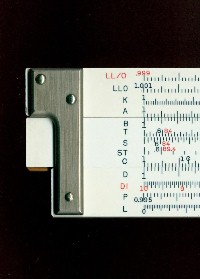
Fig. 2
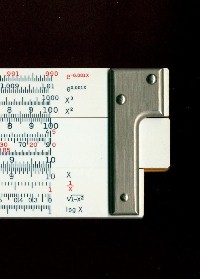
Fig. 3

Fig. 4
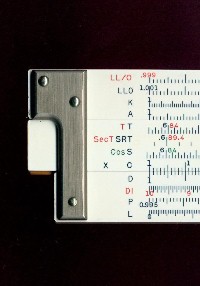
Fig. 5
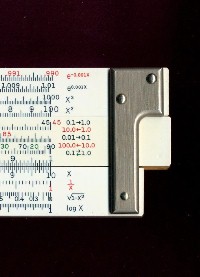
Fig. 6
|
|
| |
|
|